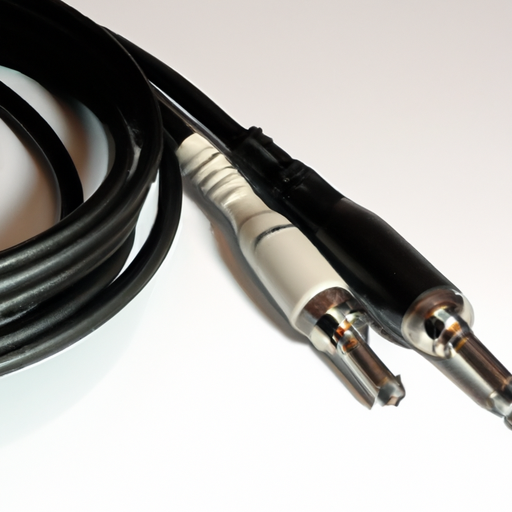So you’re setting up your home recording studio and you’ve started to come across terms like “balanced” and “unbalanced” audio connections. But what exactly do these terms mean, and how do they affect the quality of your audio? In this article, we will unravel the intricacies of balanced and unbalanced audio connections, shedding light on their differences and helping you understand which one is best suited for your recording needs. Whether you’re a beginner or a seasoned pro, this article will guide you through the world of audio connections and empower you to make informed decisions for your recording setup.
Understanding Audio Connections
When it comes to understanding audio connections, it’s important to have a clear understanding of the different types available. Audio connections are used to transmit sound signals from one device to another, ensuring that the audio quality is maintained throughout the signal path. There are two main types of audio connections: balanced and unbalanced.
Defining audio connections
Audio connections refer to the cables and connectors that are used to transmit audio signals between devices. These connections can vary in terms of their design, functionality, and the level of signal quality they provide. The type of audio connection you choose will depend on the specific audio equipment you are using and the purpose for which you are using it.
Purpose of audio connections
The purpose of audio connections is to ensure accurate and reliable transmission of audio signals. Whether you are using audio connections in a professional sound studio, for live performances, or in home audio systems, the goal is always to achieve the highest quality sound reproduction possible. Different types of audio connections offer different benefits and are suited for different applications. Understanding the purpose of each type of connection will help you make informed decisions when it comes to setting up your audio system.
Detailed look at Balanced Audio Connections
Definition of balanced audio connections
Balanced audio connections are designed to minimize noise and interference in audio transmission. These connections use three conductors: two for the audio signal and one for the ground. The audio signal is transmitted in a differential manner, meaning that the positive and negative phases of the signal are transmitted separately.
How balanced audio connections work
Balanced audio connections work by using a technique called common-mode rejection. This means that any noise or interference that is picked up by the cable is cancelled out because both the positive and negative phases of the signal are affected equally. This helps to ensure a clean and accurate representation of the audio signal.
Advantages of balanced audio connections
One of the main advantages of balanced audio connections is their ability to reject noise and interference. This makes them ideal for use in environments where there is a lot of electrical interference, such as sound studios or live performance venues. Balanced connections also tend to have a longer cable run without significant signal degradation compared to unbalanced connections.
Disadvantages of balanced audio connections
One potential disadvantage of balanced audio connections is that they require more complex circuitry and additional components. This can make them more expensive than unbalanced connections. Additionally, not all audio equipment is equipped with balanced audio inputs and outputs, so compatibility can sometimes be an issue.
Exploring Unbalanced Audio Connections
Understanding unbalanced audio connections
Unbalanced audio connections are the more commonly used type of audio connection in consumer-level equipment. They use two conductors: one for the audio signal and one for the ground. The audio signal is transmitted as a single-ended signal.
Mechanism of unbalanced audio connections
Unbalanced audio connections work by transmitting the audio signal on a single conductor, with the ground serving as a reference point. This simpler design makes unbalanced connections less expensive and easier to implement compared to balanced connections.
Upsides of unbalanced audio connections
The main advantage of unbalanced audio connections is their simplicity and widespread compatibility. Most consumer audio equipment, such as home audio systems or car audio systems, utilize unbalanced connections. These connections are also more readily available and can be found in standard audio cables.
Downsides of unbalanced audio connections
One of the drawbacks of unbalanced audio connections is their increased susceptibility to noise and interference. Since the audio signal is transmitted on a single conductor, any noise or interference that is picked up along the way can impact the quality of the audio signal. Additionally, unbalanced connections may not be suitable for long cable runs as the signal degradation can become noticeable.
Typical Situations for Using Balanced Audio Connections
In sound studios
Balanced audio connections are commonly used in sound studios due to their ability to reject interference and provide high-quality audio signals. In a studio setting, where the utmost accuracy and fidelity are required, balanced connections are essential for capturing and reproducing sound accurately.
In live performances
In live performances, where the audio equipment is exposed to a multitude of electrical sources and potential interference, balanced audio connections are crucial. They help eliminate unwanted noise and ensure that the audio signal is clean and noise-free, providing a better experience for both the performers and the audience.
In Broadcasting
Broadcasting facilities also rely heavily on balanced audio connections to ensure the highest quality audio transmissions. Balanced connections help maintain the integrity of the audio signal during broadcasting, avoiding any unwanted distortion or interference.
Common Settings for Unbalanced Audio Connections
In home audio systems
Unbalanced audio connections are commonly found in home audio systems. From stereo systems to soundbars, most consumer-level audio equipment is designed to work with unbalanced connections. Their simplicity and widespread availability make them the ideal choice for home audio setups.
In car audio systems
Car audio systems also rely on unbalanced connections. Since cars are prone to electrical interference from the engine and other components, unbalanced connections are a suitable option due to their simplicity and compatibility with standard audio cables.
In musical instruments
Musical instruments, such as electric guitars or keyboards, typically use unbalanced connections. These connections allow for easy integration with various audio equipment, such as amplifiers or audio interfaces, making them a common choice among musicians.
The Role of Interference in Audio Connections
Explaining interference
Interference refers to any unwanted electrical signals that can affect the integrity of the audio signal. This interference can come from various sources, such as electromagnetic fields, radio frequencies, or ground loops. Interference can negatively impact the quality of the audio signal, resulting in unwanted noise, distortion, or even complete signal loss.
Effects of Interference on balanced audio connections
Balanced audio connections are designed to minimize the effects of interference. Since the audio signal is transmitted differentially, any interference that is picked up by the cable will affect both the positive and negative phases equally, resulting in cancellation. This helps ensure that the audio signal remains free from interference and retains its original quality.
Effects of Interference on unbalanced audio connections
Unbalanced audio connections are more susceptible to interference compared to balanced connections. Since the audio signal is transmitted on a single conductor, any interference that is picked up along the way can impact the quality of the audio signal. This can lead to unwanted noise, hum, or distortion in the audio output.
Differentiating Between Balanced and Unbalanced Cables
Visual differences
One way to differentiate between balanced and unbalanced audio cables is by examining their connectors. Balanced cables typically use XLR connectors, which have three pins, while unbalanced cables often use RCA connectors, which have two pins. Additionally, the construction of the cable itself may differ, with balanced cables often having an additional shield or insulation layer.
Functional differences
The main functional difference between balanced and unbalanced cables lies in how they transmit the audio signal. Balanced cables transmit the audio signal differentially, using separate conductors for the positive and negative phases. Unbalanced cables, on the other hand, transmit the audio signal as a single-ended signal on a single conductor.
Cost differences
Balanced cables tend to be more expensive than unbalanced cables. This is due to the additional components required for the balanced connection, such as the extra conductor and the circuitry needed to transmit and receive the audio signal differentially. Unbalanced cables, with their simpler design, are generally more affordable and widely available.
Comparing Balanced and Unbalanced Connections
Performance comparison
In terms of performance, balanced audio connections offer superior noise rejection and signal integrity compared to unbalanced connections. Balanced connections are able to effectively cancel out any interference picked up along the cable, resulting in cleaner and more accurate audio reproduction. Unbalanced connections, while simpler and more cost-effective, may introduce noise or interference into the audio signal.
Situational advantages
The choice between balanced and unbalanced connections depends on the specific application and the environment in which the audio equipment will be used. Balanced connections excel in situations where electrical interference is prevalent, such as in professional sound studios or live performances. Unbalanced connections are more suitable for everyday consumer applications, where simplicity and compatibility are prioritized.
Conversion between Balanced and Unbalanced Audio Connections
The need for conversion
There may be situations where you need to convert between balanced and unbalanced audio connections. This could be due to compatibility issues between two pieces of audio equipment or the need to integrate different types of connections within a larger audio system. In such cases, audio converters or adapters can be used to bridge the gap between the two connection types.
Conversion methods
There are different methods available for converting between balanced and unbalanced audio connections. One common method is to use a direct box or a DI box, which can convert a balanced signal to an unbalanced signal or vice versa. Another method is to use audio interface devices that offer both balanced and unbalanced inputs and outputs, allowing for seamless integration between the two connection types.
Potential issues with conversion
While audio conversion between balanced and unbalanced connections is possible, it is important to note that it may introduce additional noise or signal degradation. The quality of the conversion depends on the quality of the conversion device used. It is always best to use high-quality converters or interface devices to minimize any potential issues.
Future of Audio Connections
Advancements in technology
As technology continues to evolve, we can expect advancements in audio connection technologies. These advancements may include improved noise cancellation techniques, higher bandwidth capabilities, and increased compatibility between different connection types. The future of audio connections looks promising, with the potential for even higher quality and more reliable audio transmission.
Potential changes in usage patterns
As audio streaming services and wireless audio technologies become more popular, we may see a shift in the usage patterns of audio connections. The demand for traditional wired connections may decrease as more users opt for wireless options. However, there will always be a need for high-quality wired connections in professional audio settings where accuracy and fidelity are paramount.
Impact on balanced vs unbalanced connections decision
The ongoing advancements in technology and potential changes in usage patterns may have an impact on the balanced vs unbalanced connections decision. As wireless audio transmission improves, the need for wired connections may diminish in certain applications. However, balanced connections will continue to be crucial in professional settings where the highest level of audio quality and noise rejection is required.
In conclusion, understanding audio connections is essential for achieving the best audio quality in any situation. Balanced audio connections offer superior noise rejection and signal integrity, making them ideal for professional settings. Unbalanced connections, on the other hand, are more commonly found in consumer-level equipment due to their simplicity and widespread availability. The choice between balanced and unbalanced connections depends on the specific requirements of the audio setup and the environment in which it will be used. With the ongoing advancements in technology, we can expect further improvements in audio connection technologies, potentially impacting the way we use and perceive audio connections in the future.










